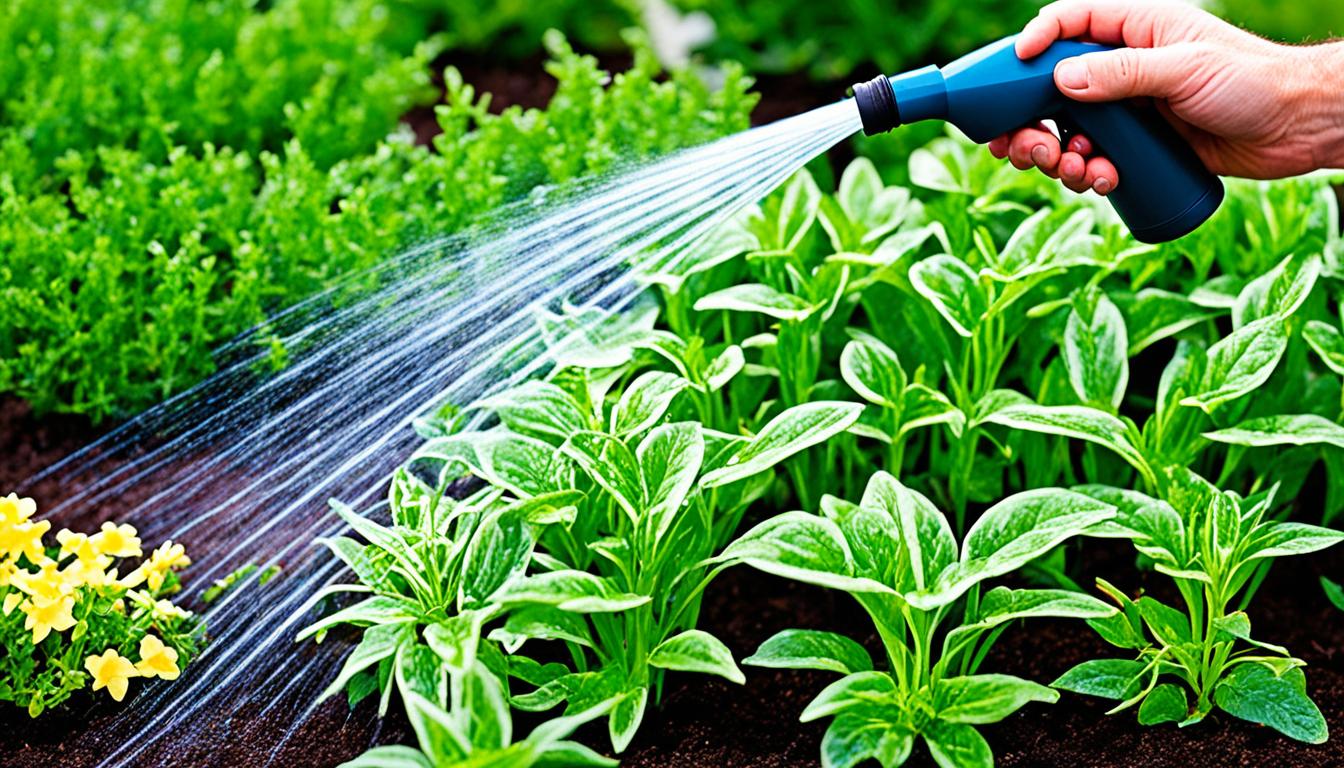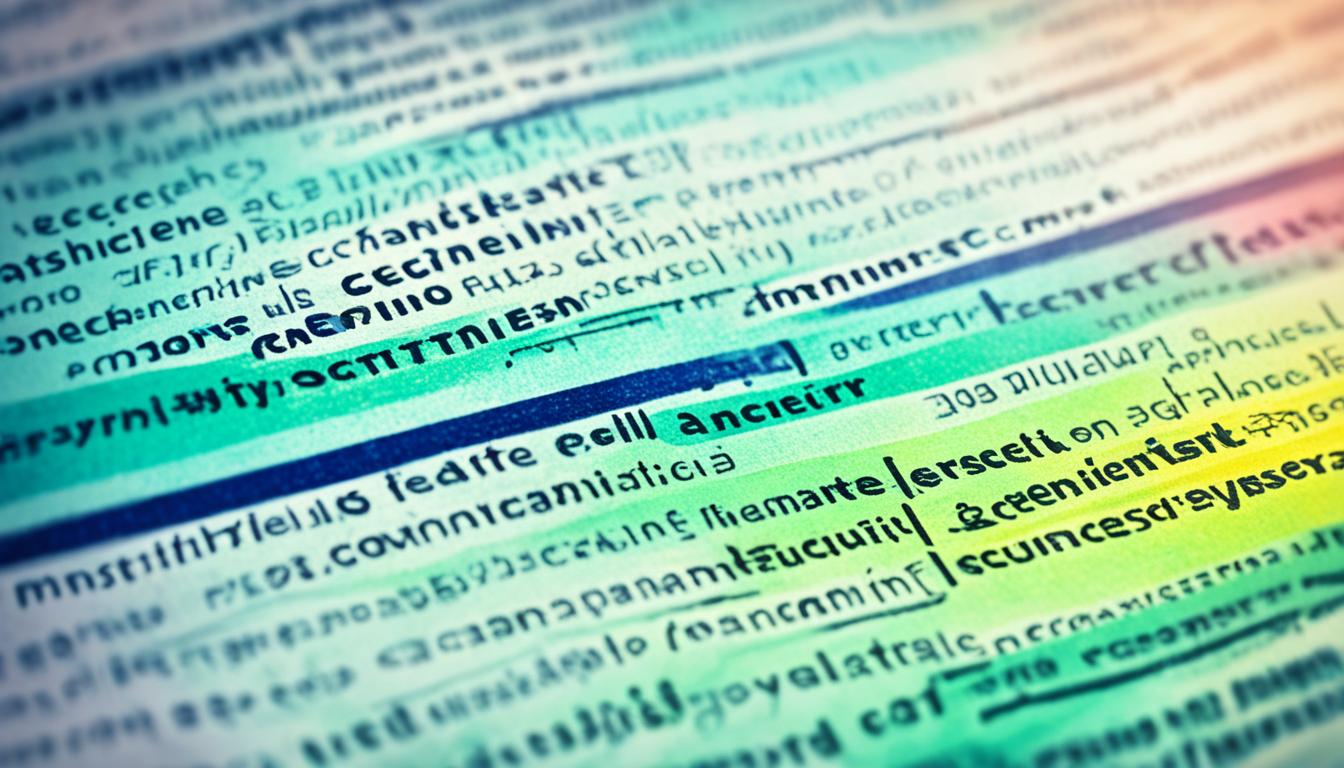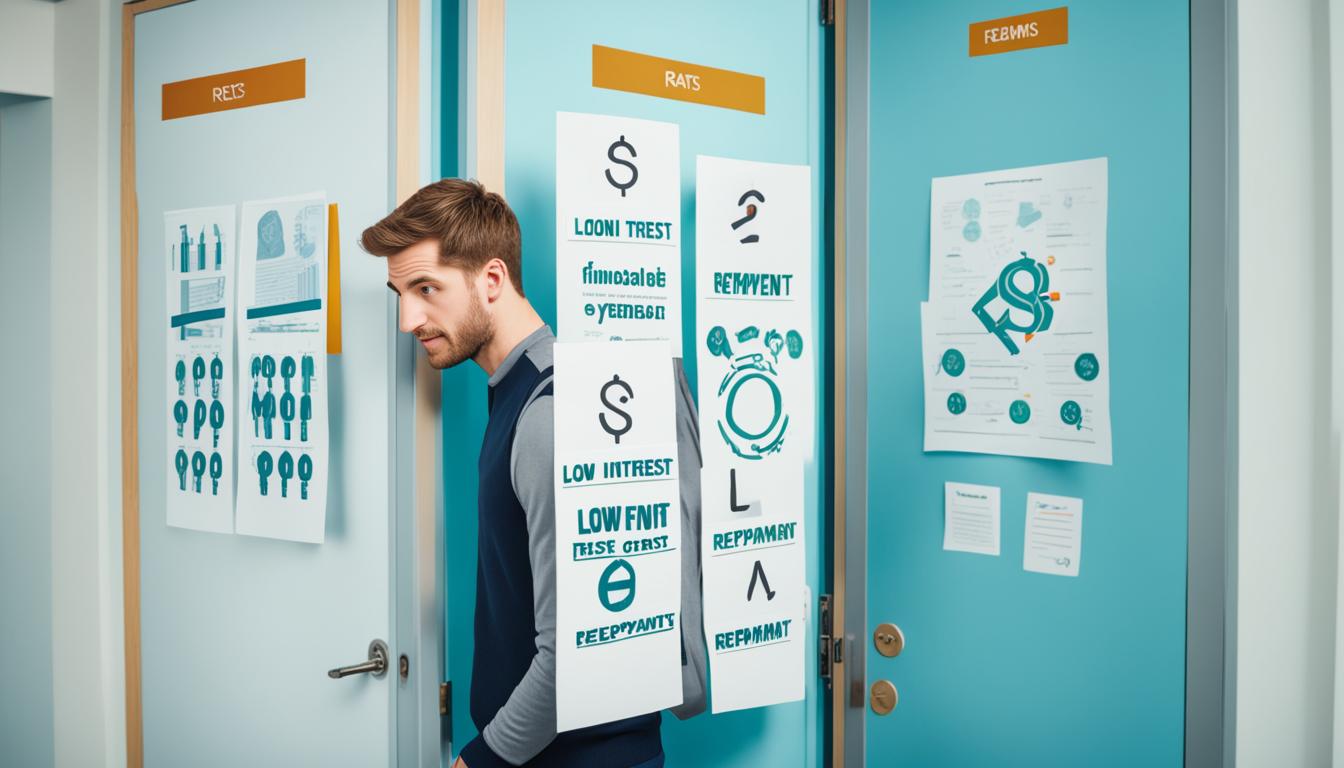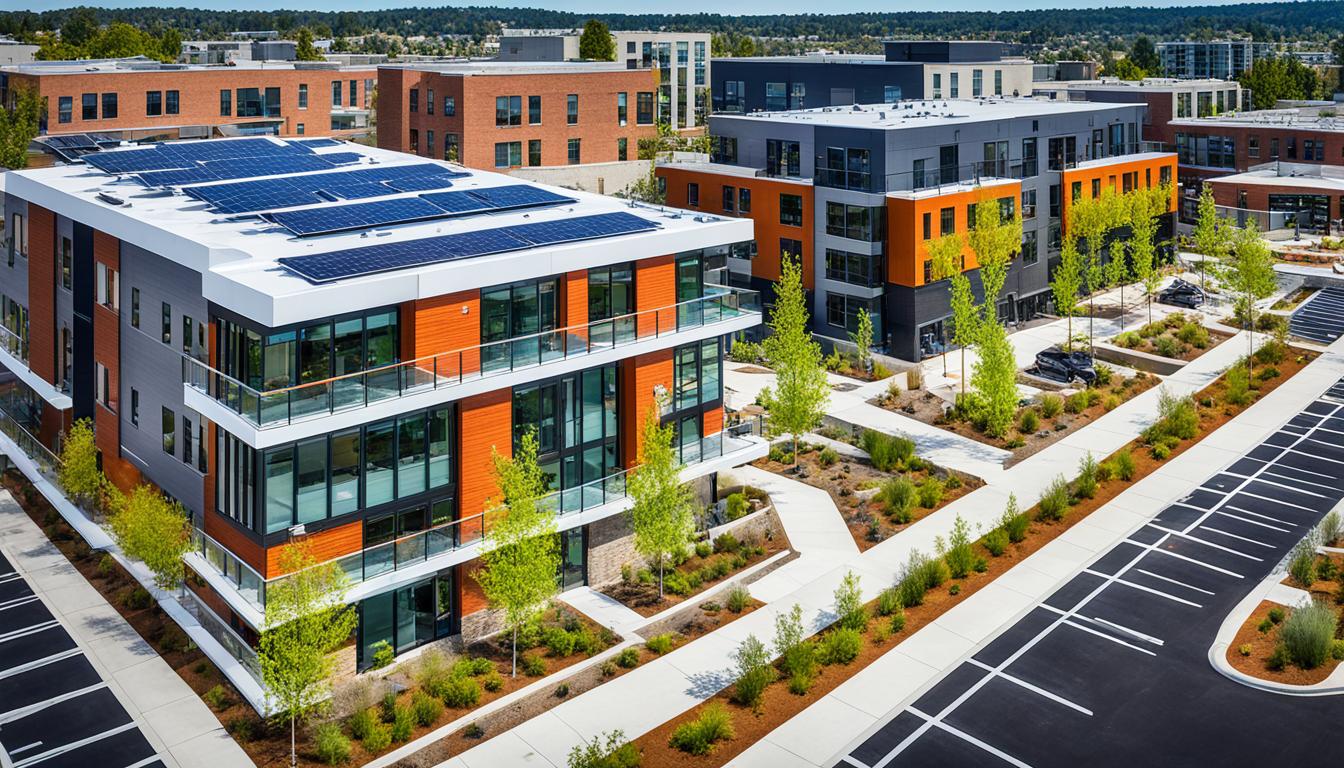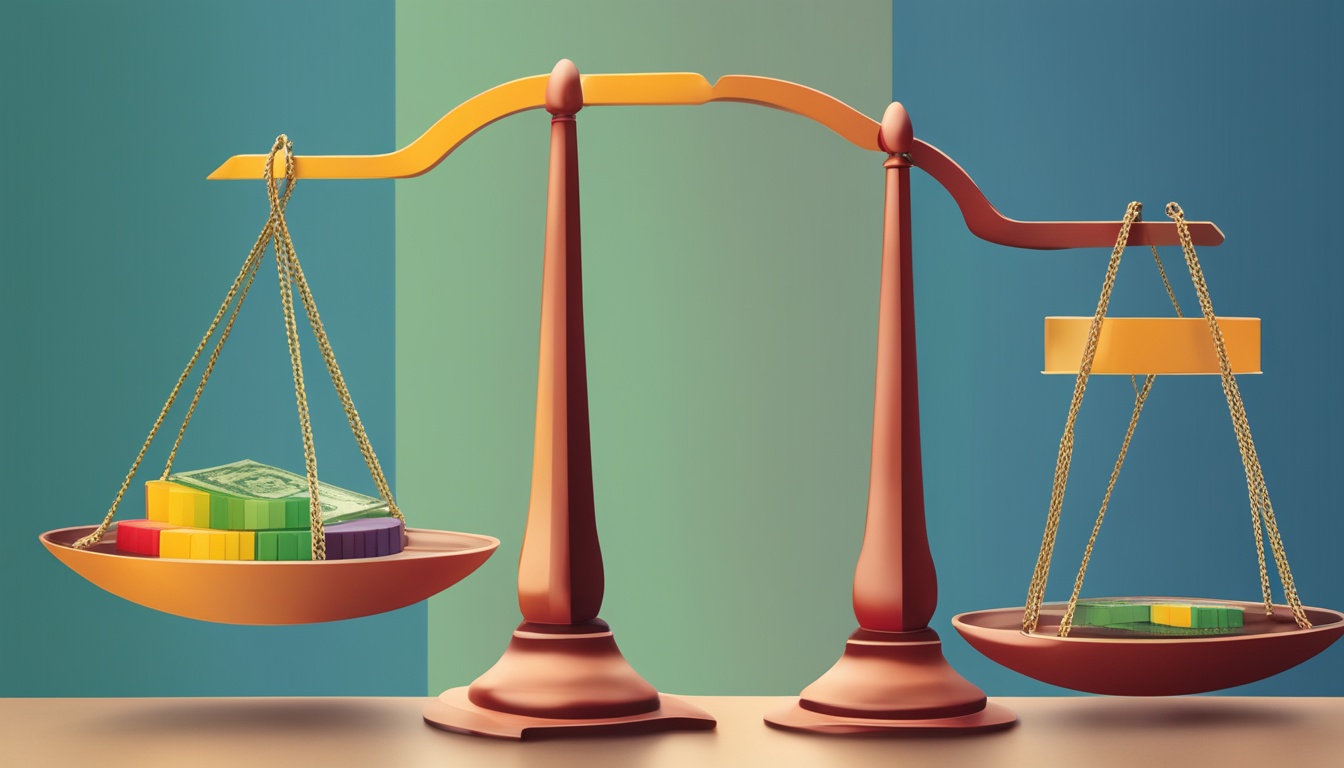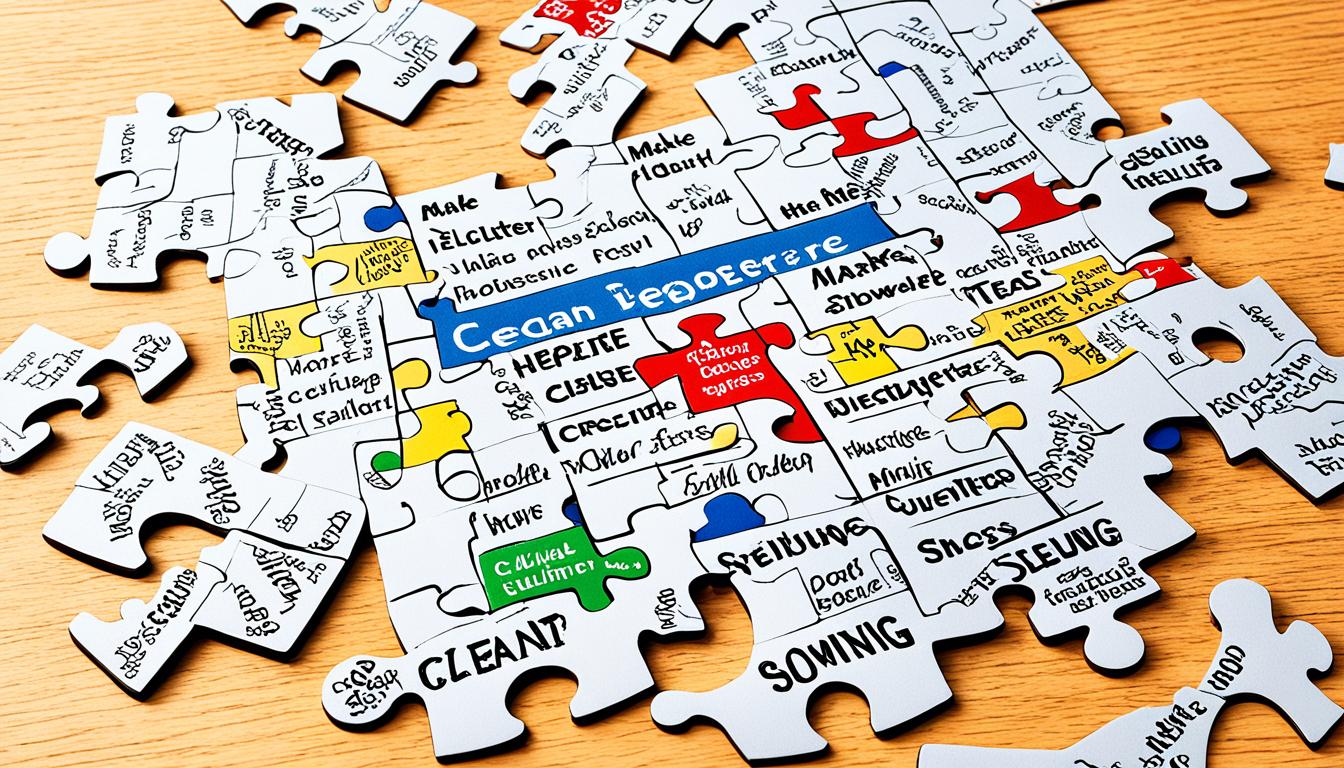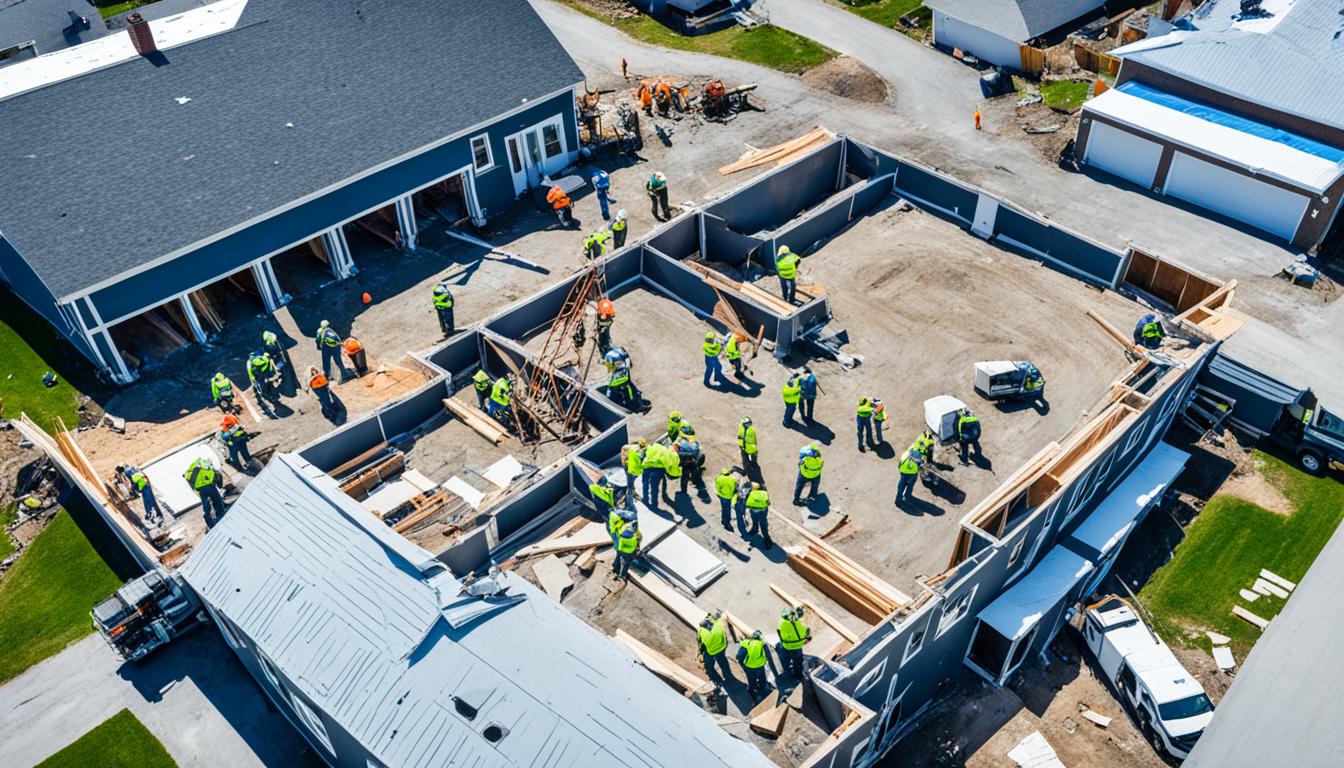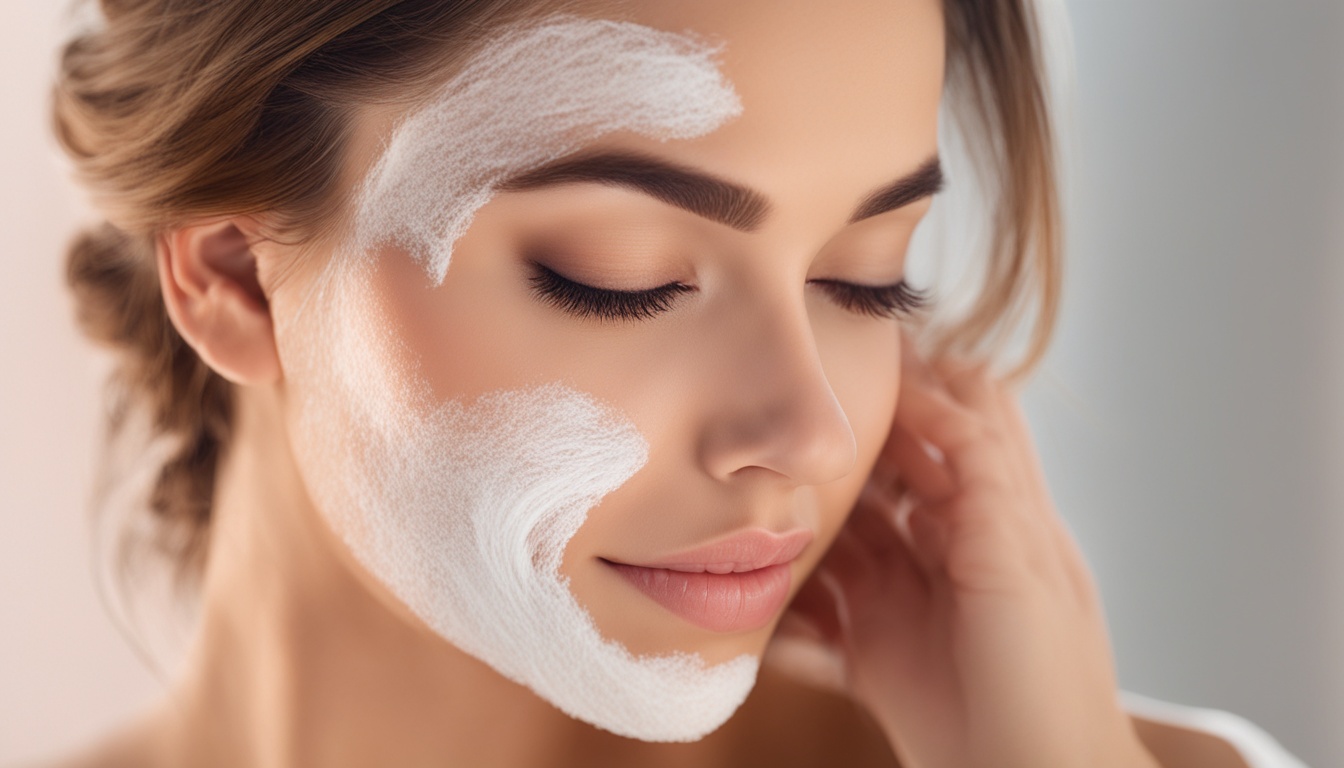Keeping your plants healthy means watering them the right way. It’s important to know the type of plant you have and its size. You should also look at the soil, how much sun the plant gets, and the weather. And, remember when you water is also key.
To water your garden well, follow these tips: Water directly at the base. Always check if the soil is dry before adding more. Morning time is the best for watering. Do it slowly. Focus the water where the roots are. Make sure not to use too much water. But, don’t let your plants completely dry out either. Use mulch to keep the soil moist.
Water Where the Roots Are
When watering plants, it’s vital to focus on the soil. Ensure it soaks through the whole root system. Roots spread as far as the plant and can be deep.
This way of watering reaches the roots directly. It keeps the plant hydrated and healthy. When the roots get water first, the plant uses it better.
Focusing water at the roots stops water from running off. It helps the roots grow stronger by searching down for water.
Watering like this also lowers the chance of too much water. The plant only takes what it needs. This avoids the problems of too wet soil for the plant.
Check the Soil Before Watering
Before you water your plants, it’s key to check the soil’s moisture. This helps ensure they get just the right amount of water. You can do this by feeling the soil with your hand or by using a moisture meter a few inches down.
When testing the soil, see if it’s dry or moist. Dry soil means it’s time to water. Moist soil, on the other hand, tells you to hold off on watering. Knowing your soil’s moisture level is vital for your plants’ health and to avoid water-related problems.
Is the soil dry several inches deep? This is a sure sign your plants need water. Dry soil means they’re not getting enough water. So, in this situation, water them to give their roots the moisture they need for growth.
If the soil is still moist, it’s better to wait before watering. Too much water can make the soil too wet. This can prevent plants from taking in nutrients they need. By waiting, you avoid overwatering and keep the moisture in balance for your plants.
A moisture meter helps you get an exact read on the soil’s moisture. It’s great for checking moisture levels in larger gardens or for plants that are picky about moisture.
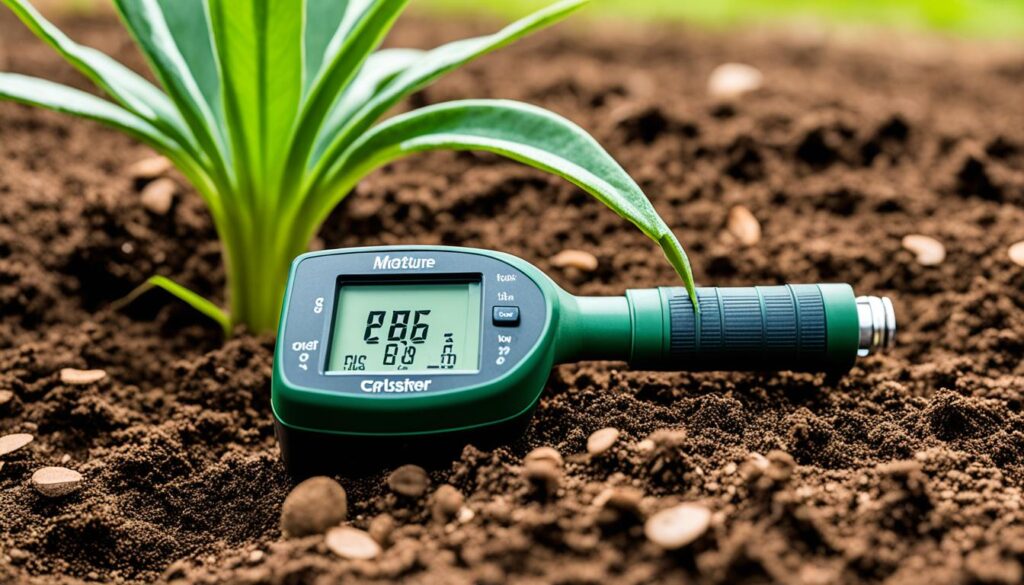
Keep checking the soil moisture and adjust your watering as needed. This way, your plants will get just enough water without harm. Now that you see how important it is to check the soil’s moisture, you’re all set to water your plants the right way. This will keep them healthy and thriving.
Water in the Morning
The best time to water your plants is in the morning. It lets the leaves dry in the sun. This helps lower the chance of them getting sick because of being wet too long. Plus, plants get to take in the water they need. The morning sun also dries any extra water, reducing problems caused by too much moisture.
Plants that can easily get sick from wet leaves benefit a lot from morning watering. It gets them ready for the day. They are less likely to have trouble dealing with the heat.
Evening watering is fine if mornings are too busy for you. But avoid doing it when it’s really hot. The water might disappear too quickly for the plants to use. If leaves stay wet all night, they could get sick from fungi.
Benefits of Morning Watering:
- Allows leaves to dry out during the day
- Reduces the risk of fungal diseases
- Provides ample time for plants to absorb moisture
- Helps plants start the day fully hydrated
| Time of Day | Advantages | Disadvantages |
|---|---|---|
| Morning | – Leaves dry out during the day – Reduced risk of fungal diseases – Ample time for plant absorption |
– May be challenging due to schedule conflicts |
| Evening | – Convenient for those with morning commitments – Cooler temperatures reduce evaporation |
– Increased risk of fungal diseases if leaves remain wet overnight |
| Hottest Part of the Day | – Water evaporates quickly | – Not effective in hydrating plants |
Water Slowly
Watering your plants slowly is important. It helps the roots soak up the water well. When the top of the soil seems dry, don’t rush to water everything at once. Instead, take it slow. Let the water sink in slowly and make the top soil damp.
This slow approach is great for plants. It helps the water go deep where the roots are. This means the water helps the plants more and doesn’t just flow away on the surface.
Slow watering lets the plants drink up water without stress. It also helps their roots spread out and grow stronger. This way, the plants get more food and water to make them healthy.
Benefits of Gradual Soaking
The slow soak method is good for many reasons:
- It makes roots grow deep, making plants tough against dry times.
- Helps plants take in water and food better.
- Keeps them from getting too much water and rot.
- It saves water and helps the environment.
- Builds a strong underground network for the plants.
Remember, watering slowly is key. It gets the water deep down where it helps plants most. It’s about giving your plants the best chance to grow strong but also using water well.
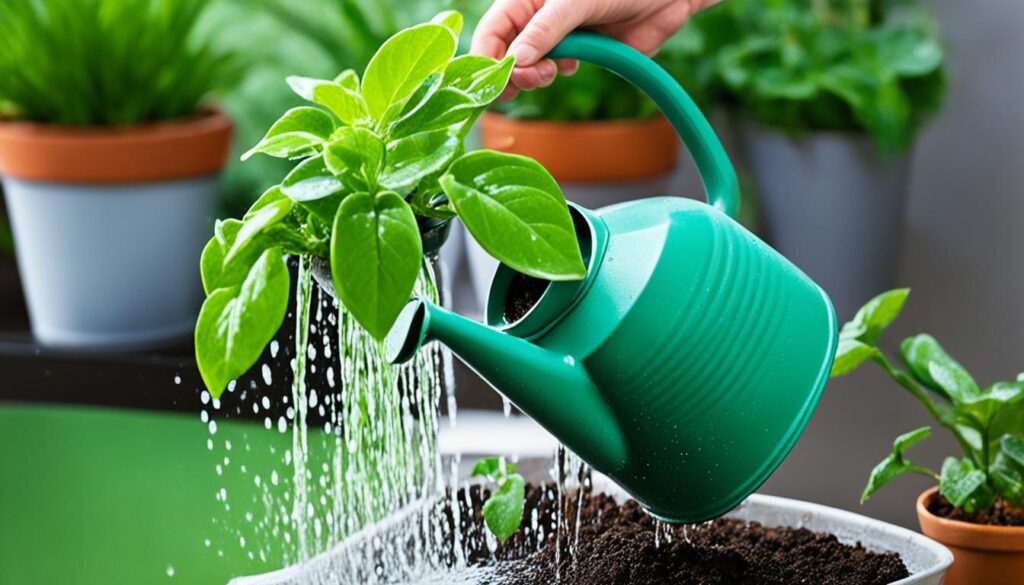
Example of Gradual Soaking Technique:
One good way to do this is with a drip system or a soaker hose. These let water out gently right by the plants. This ensures all the plants get the same amount of water.
Here’s how to use them the right way:
- Place the drip system or hose close to your plants but not on top of them.
- Turn the water on just a little bit, so it flows slowly.
- Let it water for a while, making the soil moist a few inches deep.
- Check the soil now and then to see if it’s wet enough. Change how long you water as needed.
By using the slow watering method, your plants will get just the right amount of water. It makes for a lush, healthy garden in the end.
Make Every Drop Count
To make your garden water-efficient, use the right tools and methods. You can prevent water from going to waste and make sure it gets to the plant’s roots.
The watering wand is a great tool for this. It’s a long, slim device that lets you water plants exactly where they need it. This cuts down on waste and stops water from hitting leaves, possibly causing fungal diseases.
Using a drip irrigation system is also smart. It sends water straight to the plant’s roots through tubes and emitters. This means less water is lost to evaporation.
Soaker hoses are another good choice. They let water out slowly and evenly into the soil, reaching the plant’s roots in the best way.
It’s better to water your garden early in the morning or when the day is cooling down. This way, less water evaporates. Plus, blocking the wind from your plants can help save water too.
By choosing the right tools and methods, your garden will use water well. This is good for your plants and for saving this important resource.
Comparison of Watering Tools
| Watering Tool | Advantages | Disadvantages |
|---|---|---|
| Watering Wand | – Allows precise watering – Minimizes water wastage – Prevents leaf wetting |
– Requires manual operation |
| Drip Irrigation System | – Delivers water directly to root zone – Reduces evaporation – Conserves water |
– Initial setup can be complex |
| Soaker Hoses | – Releases water slowly and evenly – Directs water to root zone – Water-saving |
– Requires proper placement and care |
Don’t Overwater
Plants need water to grow. But too much water can be harmful. It causes a lack of oxygen in the soil which hurts the plant. Let the top of the soil dry a bit before watering again. This is even more important for plants in pots.
Getting the water balance right is key. Too much water drowns the roots. Roots need both water and air. Overwatering makes the soil too wet and pushes out the air. This can cause roots to rot and the plant to die.
It’s better for plants to be a little dry than always wet. Letting the top layer of soil dry out helps the roots grow strong. They grow deeper into the soil to find water. This makes the plant stronger and healthier.
Plants in pots are more at risk of too much water. The water can’t drain as well in pots. To keep them healthy, water deeply but less often. This way, the water gets down to the roots where it’s needed. And the soil has time to dry a bit.
Different plants have different water needs. Cacti like less water, ferns like more. Know what your plant needs and water it that way.
Signs of Overwatering
Knowing when a plant is getting too much water is important. Watch for these signs:
- Yellowing or wilting leaves
- Mold or fungus growth in the soil or on the plant
- Rotting or mushy roots
- Stunted growth
- Foul odor coming from the soil
If you see these signs, change your watering. Let the soil dry before watering again. Make sure the pot has good drainage.
| Common Mistakes to Avoid when Watering Plants |
|---|
| Watering too frequently |
| Watering at the wrong time of day |
| Ignoring the specific watering needs of different plant species |
| Not checking the soil moisture before watering |
| Using inadequate drainage in containers |
Don’t Let Them Go Dry
In hot weather, some plants might look like they’re wilting to save water. But, it’s key to keep the soil from getting completely dry. If the soil dries out, plants can’t absorb water well and this harms their roots. It’s vital to watch the soil’s moisture to keep your plants healthy.
Importance of Soil Moisture
Soil moisture is vital for plant health. If the soil is too dry, plants can’t get the water, nutrients, and oxygen they need. This can cause them not to grow well, look weak, and even harm their roots. Keeping the soil moist helps plants grow as best as they can.
Monitoring Soil Moisture
Checking the soil’s moisture often is important to keep plants from drying out. You can check the soil’s moisture in a few ways:
- Use a moisture meter to check how wet the soil is.
- Poke your finger in the soil. If it’s dry on top, it might need water.
- Look at the topsoil. If it’s cracked, the soil is too dry.
Maintaining Proper Soil Moisture
To avoid root hair damage, here’s what you can do:
- Water deeply so the roots get water, not just the surface.
- Water early or late to cut down on water lost to the air.
- Put mulch around plants to keep the soil moist and slow drying.
- Watch the weather. If it’s hot and dry, plants need more water.
Keeping the soil at the right moisture level helps plants stay healthy and grow well.
Conclusion
Knowing how to water plants well is crucial for their health and saving water. Through good watering methods, your plants will get the right amount of water and will grow better. Watering at the base sends water right to where the plant needs it most.
It’s also key to water your plants in the morning. This lets their leaves dry out during the day, which stops fungal diseases. By watering slowly, you use water better. This helps your plants grow and saves water.
To keep your plants healthy and save water, be careful not to overwater or let them dry out. Using mulch holds in moisture and stops water from evaporating too quickly. These methods create the perfect spot for your plants. This encourages their health and a stunning garden, all while helping the environment.
FAQ
How should I water plants effectively?
To water plants well, focus on the root area. Make sure the soil around the roots gets completely wet. This helps the plant absorb water and grow better.
How do I check if the soil needs watering?
Before you water, feel the soil a few inches down. Use your hand or a tool, like a moisture meter.
If it’s dry, go ahead and water. But if it’s still moist, give it some time before watering again.
What is the best time to water plants?
The top time to water is in the morning. This lets the sun dry the leaves, which helps prevent diseases. If the morning doesn’t work, evening is a good backup time.
How should I water plants without causing runoff?
To stop water from running off, let it soak in slowly. Start with a small amount of water and add more as needed. This way, the soil can absorb it all.
Are there any tools to make watering more efficient?
Tools like a watering wand or a drip system can make watering better. They deliver water right where it’s needed. This reduces wasted water and keeps the plants happier.
How much should I water my plants?
Don’t water too much. Many plants like a little drying time between waterings. A good rule is to water deeply but less often, promoting strong growth.
Should I let the soil go completely dry before watering again?
Don’t let the soil get bone dry. Even if a few leaves wilt, it’s better than risking root harm from too-dry soil. Good water habits keep your plants healthy.
What are the key points to remember for effective plant watering?
Always aim water at the roots. Check moisture before you water. Choose morning for watering if you can.
Water slowly to let the soil absorb it. Don’t over-water. Keep the soil from drying out completely. And, use mulch to keep moisture in.
